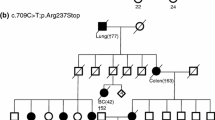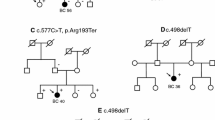Abstract
RAD51C, a RAD51 paralogue involved in homologous recombination, is a recently established Fanconi anemia and breast cancer predisposing factor. In the initial report, RAD51C mutations were shown to confer a high risk for both breast and ovarian tumors, but most of the replication studies published so far have failed to identify any additional susceptibility alleles. Here, we report a full mutation screening of the RAD51C gene in 147 Finnish familial breast cancer cases and in 232 unselected ovarian cancer cases originating from Finland and Sweden. In addition, in order to resolve whether common RAD51C SNPs are risk factors for breast cancer, we genotyped five tagging single nucleotide polymorphisms, rs12946522, rs304270, rs304283, rs17222691, and rs28363312, all located within the gene, from 993 Finnish breast cancer cases and 871 controls for cancer associated variants. Whereas, none of the studied common SNPs associated with breast cancer susceptibility, mutation analysis revealed two clearly pathogenic alterations. RAD51C c.-13_14del27 was observed in one familial breast cancer case and c.774delT in one unselected ovarian cancer case, thus confirming that RAD51C mutations are implicated in breast and ovarian cancer predisposition, although their overall frequency seems to be low. Independent identification of the very recently reported RAD51C c.774delT mutation in yet another patient originating from Sweden suggests that it might be a recurrent mutation in that population and should be studied further. The reliable estimation of the clinical implications of carrying a defective RAD51C allele still requires the identification of additional mutation positive families.


Similar content being viewed by others
References
Antoniou AC, Pharoah PD, McMullan G, Day NE, Stratton MR, Peto J, Ponder BJ, Easton DF (2002) A comprehensive model for familial breast cancer incorporating BRCA1, BRCA2 and other genes. Br J Cancer 86:76–83
Erkko H, Xia B, Nikkilä J, Schleutker J, Syrjäkoski K, Mannermaa A, Kallioniemi A, Pylkäs K, Karppinen SM, Rapakko K, Miron A, Sheng Q, Li G, Mattila H, Bell DW, Haber DA, Grip M, Reiman M, Jukkola-Vuorinen A, Mustonen A, Kere J, Aaltonen LA, Kosma VM, Kataja V, Soini Y, Drapkin RI, Livingston DM, Winqvist R (2007) A recurrent mutation in PALB2 in Finnish cancer families. Nature 446:316–319
Walsh T, King MC (2007) Ten genes for inherited breast cancer. Cancer Cell 11:103–105
Howlett NG, Taniguchi T, Olson S, Ox B, Waisfisz Q, De Die-Smulders C, Persky N, Grompe M, Joenje H, Pals G, Ikeda H, Fox EA, D’Andrea AD (2002) Biallelic inactivation of BRCA2 in Fanconi anemia. Science 297:606–609
Levy-Lahad E (2010) Fanconi anemia and breast cancer susceptibility meet again. Nat Genet 42:368–369
Vaz F, Hanenberg H, Schuster B, Barker K, Wiek C, Erven V, Neveling K, Endt D, Kesterton I, Autore F, Fraternali F, Freund M, Hartmann L, Grimwade D, Roberts RG, Schaal H, Mohammed S, Rahman N, Schindler D, Mathew CG (2010) Mutation of the RAD51C gene in a Fanconi anemia-like disorder. Nat Genet 42:406–409
Meindl A, Hellebrand H, Wiek C, Erven V, Wappenschmidt B, Niederacher D, Freund M, Lichtner P, Hartmann L, Schaal H, Ramser J, Honisch E, Kubisch C, Wichmann HE, Kast K, Deissler H, Engel C, Muller-Myhsok B, Neveling K, Kiechle M, Mathew CG, Schindler D, Schmutzler RK, Hanenberg H (2010) Germline mutations in breast and ovarian cancer pedigrees establish RAD51C as a human cancer susceptibility gene. Nat Genet 42:410–414
Masson JY, Stasiak AZ, Stasiak A, Benson FE, West SC (2001) Complex formation by the human RAD51C and XRCC3 recombination repair proteins. Proc Natl Acad Sci USA 98:8440–8446
Masson JY, Tarsounas MC, Stasiak AZ, Stasiak A, Shah R, McIlwraith MJ, Benson FE, West SC (2001) Identification and purification of two distinct complexes containing the five RAD51 paralogs. Genes Dev 15:3296–3307
Liu Y, Masson JY, Shah R, O’Regan P, West SC (2004) RAD51C is required for Holliday junction processing in mammalian cells. Science 303:243–246
Moldovan GL, D’Andrea AD (2009) How the Fanconi anemia pathway guards the genome. Annu Rev Genet 43:223–249
Seal S, Thompson D, Renwick A, Elliott A, Kelly P, Barfoot R, Chagtai T, Jayatilake H, Ahmed M, Spanova K, North B, McGuffog L, Evans DG, Eccles D, Breast Cancer Susceptibility Collaboration (UK), Easton DF, Stratton MR, Rahman N (2006) Truncating mutations in the Fanconi anemia J gene BRIP1 are low-penetrance breast cancer susceptibility alleles. Nat Genet 38:1239–1241
Huusko P, Pääkkönen K, Launonen V, Pöyhönen M, Blanco G, Kauppila A, Puistola U, Kiviniemi H, Kujala M, Leisti J, Winqvist R (1998) Evidence of founder mutations in Finnish BRCA1 and BRCA2 families. Am J Hum Genet 62:1544–1548
Hartikainen JM, Tuhkanen H, Kataja V, Eskelinen M, Uusitupa M, Kosma VM, Mannermaa A (2006) Refinement of the 22q12–q13 breast cancer-associated region: evidence of TMPRSS6 as a candidate gene in an eastern Finnish population. Clin Cancer Res 12:1454–1462
Kumar S, Nei M, Dudley J, Tamura K (2008) MEGA: a biologist-centric software for evolutionary analysis of DNA and protein sequences. Brief Bioinform 9:299–306
Shih HA, Nathanson KL, Seal S, Collins N, Stratton MR, Rebbeck TR, Weber BL (2000) BRCA1 and BRCA2 mutations in breast cancer families with multiple primary cancers. Clin Cancer Res 6:4259–4264
Akbari MR, Tonin P, Foulkes WD, Ghadirian P, Tischkowitz M, Narod SA (2010) RAD51C germline mutations in breast and ovarian cancer patients. Breast Cancer Res 12:404
Zheng Y, Zhang J, Hope K, Niu Q, Huo D, Olopade OI (2010) Screening RAD51C nucleotide alterations in patients with a family history of breast and ovarian cancer. Breast Cancer Res Treat 124:857–861
Silvestri V, Rizzolo P, Falchetti M, Zanna I, Masala G, Palli D, Ottini L (2011) Mutation screening of RAD51C in male breast cancer patients. Breast Cancer Res 13:404
Wong MW, Nordfors C, Mossman D Pecenpetelovska G, Avery-Kiejda KA, Talseth-Palmer B, Bowden NA, Scott RJ (2011) BRIP1, PALB2, and RAD51C mutation analysis reveals their relative importance as genetic susceptibility factors for breast cancer. Breast Cancer Res Treat 127:853–859
Pang Z, Yao L, Zhang J, Ouyang T, Li J, Wang T, Fan Z, Fan T, Lin B, Xie Y (2011) RAD51C germline mutations in Chinese women with familial breast cancer. Breast Cancer Res Treat [Epub ahead of print]
Romero A, Perez-Segura P, Tosar A Garcia-Saenz JA, Diaz-Rubio E, Caldes T, de la Hoya M (2011) A HRM-based screening method detects RAD51C germ-line deleterious mutations in Spanish breast and ovarian cancer families. Breast Cancer Res Treat [Epub ahead of print]
French CA, Tambini CE, Thacker J (2003) Identification of functional domains in the RAD51L2 (RAD51C) protein and its requirement for gene conversion. J Biol Chem 278:45445–45450
Acknowledgments
We thank Dr. Aki Mustonen, Dr. Jaakko Ignatius, Dr. Karolina Partheen, nurses Kari Mononen and Outi Kajula for their help in sample and data collection, and Meeri Otsukka for technical assistance and help in patient contacts. Jenni Nikkilä and Szilivia Solyom are acknowledged for their technical assistance. This study was financially supported by (RW) the Finnish Cancer Foundation, the Sigrid Jusélius Foundation, the Academy of Finland, the University of Oulu, and the Oulu University Hospital; (KS) the Swedish Cancer Foundation, the King Gustav V Jubilée Clinic Cancer Research Foundation and the Gothenburg Medical Society; (AL) the Swedish Cancer Society.
Conflict of interest statement
None.
Author information
Authors and Affiliations
Corresponding author
Additional information
Mikko Vuorela and Katri Pylkäs contributed equally to this work.
Rights and permissions
About this article
Cite this article
Vuorela, M., Pylkäs, K., Hartikainen, J.M. et al. Further evidence for the contribution of the RAD51C gene in hereditary breast and ovarian cancer susceptibility. Breast Cancer Res Treat 130, 1003–1010 (2011). https://doi.org/10.1007/s10549-011-1677-x
Received:
Accepted:
Published:
Issue Date:
DOI: https://doi.org/10.1007/s10549-011-1677-x




